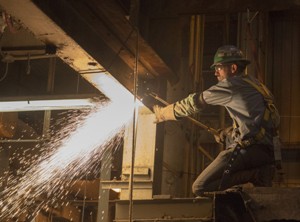Aug 25 2014
Penn State continues its pursuit of greater sustainability with the conclusion of construction on the installation of 13,645 feet (2.6 miles) of pipe to increase natural gas service to the University’s West Campus Steam Plant. Conversion from its historic use of coal to natural gas will reduce the plant’s total emissions by nearly 50 percent and help meet the University’s ambitious goal of a 35 percent overall reduction in greenhouse gas emissions by 2020 (over a 2005 baseline).
 Cutting torches are used to take down support beams during the removal of old boilers from Penn State's power plant in preparation for the facility's conversion to natural gas. Image: Patrick Mansell
Cutting torches are used to take down support beams during the removal of old boilers from Penn State's power plant in preparation for the facility's conversion to natural gas. Image: Patrick Mansell
The conversion project includes a substantial renovation and upgrade of the historic West Campus Steam Plant (WCSP), which was originally built in 1929. In addition to the pipeline installation, workers spent the summer removing equipment and reconfiguring the space to accommodate new gas-fired boilers.
Three coal-fired boilers will be replaced by two, new, high-capacity, gas-fired boilers. These will be installed in phases, with the first on-line next winter to heat the University Park campus. The 75 and 66-year-old turbines in the West Campus Steam Plant will also be replaced.
“The use of natural gas in our combined heat and power system is a highly efficient, low-carbon solution that is considered environmentally friendly by all major environmental groups." -- Paul Moser, superintendent of steam services
Both the WCSP and the East Campus Steam Plant (ECSP), built in 1972, are part of a district energy system that produces steam distributed to more than 200 individual buildings via a network of 17 miles of underground piping. A combustion turbine at the ECSP and two back-pressure steam turbines at WCSP enable the system to generate electricity as well — a concept known as combined heat and power (CHP).
Roughly 90 percent of power plants burn fuel (historically coal) to generate steam, some of which is used to spin an electrical generator turbine while the rest is vented as waste heat — resulting in only 33 percent operational efficiency. The electricity is then transmitted over long distances (resulting in notoriously heavy losses) via transmission lines for our use. The Lawrence Livermore National Laboratory estimates that nearly two-thirds of the energy used to produce electricity in the United States is wasted before it even reaches a switch or outlet.
Steam plant conversion to natural gas will reduce emissions by 50 percent
Because the steam plants at University Park are located on campus, Penn State can capture the “waste heat” and use it locally at the same time it is generating electricity. In 2013, Penn State generated 65,908,586 kilowatt hours of its own electricity on campus. This avoided purchasing that power from the grid and the accompanying production of 45,181 metric tons of greenhouse gas emissions — the equivalent of taking 9,512 passenger vehicles off the road or 6,215 homes off the electrical grid. In 2011, the campus steam system operated at 73 percent efficiency. When fully completed, Penn State’s combined heat and power system will operate at better than 80 percent — more than twice the efficiency of the industrial power grid.
The on-site power generation capability provided by the East and West Campus Steam Plants also means that University Park is able to provide 100 percent of its critical emergency power should there be a loss in the supply of electricity from public utilities (as with Hurricane Sandy in the northeast in 2012).
While the on-campus portion of the pipeline project has been completed, considerable work remains to be completed in Pleasant Gap and Snow Shoe before the gas line would be put into service. Future work at the West Campus Steam Plant will include demolition of the coal-necessitated smokestack and filtering baghouse. The conversion will eliminate the need for coal deliveries and heavy truck traffic and allow for the continued operation of the campus’s low-carbon, combined heat and power system, while ensuring compliance with the Federal Environmental Protection Agency Industrial Boiler MACT law published in January 2013.
The power plant projects are only part of the University’s effort to reduce its greenhouse gas emissions by 35 percent by 2020. The reductions will continue to be anchored with conservation efforts but also supported by a recent hydropower purchase and supplemented with a mix of carefully targeted renewables.
Public discussion about the University’s energy future and its strategies is ongoing. Penn State’s Sustainability Institute hosted an inaugural forum last fall and subsequently conducted a stakeholder case study — “Assessing Penn State’s Energy Future” — to examine the University’s internal, long-range, energy-related planning. A public meeting about the study and its report will take place from 6:30 to 8:30 p.m. Tuesday, Sept. 2, in the Alumni Lounge at the Nittany Lion Inn.
Paul Moser, Penn State’s superintendent of steam services, said that the conversion and plant upgrades are a critical part of our greenhouse gas reduction plan. “The use of natural gas in our combined heat and power system is a highly efficient, low-carbon solution that is considered environmentally friendly by all major environmental groups including the Sierra Club, Greenpeace and the Natural Resources Defense Council,” said Moser. “We are going in the right direction in the present as we continue to explore alternatives for the future.”
For additional information on how Penn State is reducing its energy consumption through increased efficiency, conservation and awareness, visit www.sustainability.psu.edu.